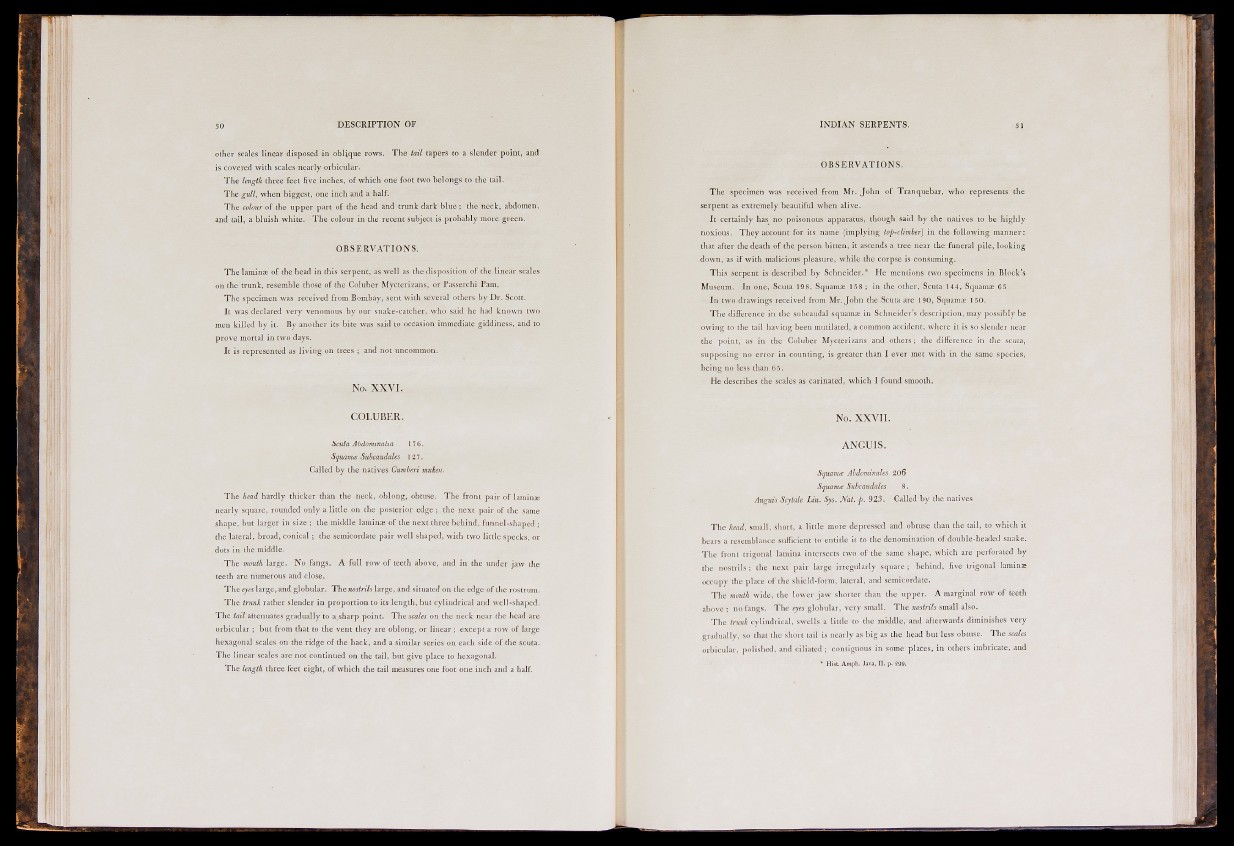
DESCRIPTION OF
other scales linear disposed in obljque rows. The tail tapers to a slender point, and
is covered with scales nearly orbicular.
The length three feet five inches, of which one foot two belongs to the tail.
The gull, when biggest, one inch and a half.
The colour of the upper part of the head and trunk dark blue ; the neck, abdomen,
and tail, a bluish white. The colour in the recent subject is probably more green.
O B S E R V A T I O N S .
The lamin® of the head in this serpent, as well as the disposition of the linear scales
on the trunk, resemble those of the Coluber Mycterizans, or Passerchi Pam.
The specimen was received from Bombay, sent with several others by Dr . Scott.
It was declared very venomous by our snake-catcher, who said he had known two
men killed by it. By another its bite was said to occasion immediate giddiness, and to
prove mortal in two days.
It is represented as living on trees ; and not uncommon.
No. XXVI.
COLUBER.
Scuta Ahdominalia 17 6.
Squama Subcaudales 12 7.
Called by the natives Cumberi muken.
The head hardly thicker than the neck, oblong, obtuse. The front pair of lamins
nearly square, rounded only a little on the posterior edge ; the next pair of the same
shape, but larger in size ; the middle laminae of the next three behind, funnel-shaped ;
the lateral, broad, conical ; the semicordate pair well shaped, with two little specks, or
dots in the middle.
The moulh large. No fangs. A full row of teeth above, and in the under jaw the
teeth are numerous and close.
The eyes large, and globular. Thtnostrils large, and situated on the edge of the rostrum.
The trunk rather slender in proportion to its length, but cylindrical and well-shaped.
The tail attenuates gradually to a sharp point. The scales on the neck near the head are
orbicular ; but from that to the vent they are oblong, or linear ; except a row of large
hexagonal scales on the ridge of the back, and a similar series on each side of the scuta.
The linear scales are not continued on the tail, but give place to hexagonal.
The length three feet eight, of which the tail measures one foot one inch and a half.
I N D I A N SERPENTS.
O B S E R V A T I O N S .
The specimen was received from Mr. John of Tranquebar, who represents the
serpent as extremely beautiful when alive.
It certainly has no poisonous apparatus, though said by the natives to be highly
noxious. They account for its name (implying top-climber) in the following manner:
that after the death of the person bitten, it ascends a tree near the funeral pile, looking
down, as if with malicious pleasure, while the corpse is consuming.
This serpent is described by Schneider.* He mentions two specimens in Block's
Museum. In one. Scuta 198, Squams 158 ; in the other. Scuta 144, Squamae 65
I n two drawings received from Mr. J o h n the Scuta are 190, Squama; 150.
The difference in the subcaudal squamas in Schneider's description, may possibly be
owing to the tail having been mutilated, a common accident, where it is so slender near
the point, as in the Coluber Mycterizans and others ; the difference in the scuta,
supposing no error in counting, is greater than I ever met with in the same species,
being no less than 6 5.
He describes the scales as carinated, which I found smooth.
No. XXVII.
ANGUIS.
Squamce Ahdominales 206
Squamce Subcaudales S.
Anguis Scytale Lin. Sys. Mt. p. 923. Called by the natives
The head, small, short, a little more depressed and obtuse than the tail, to which it
bears a resemblance sufficient to entitle it to the denomination of double-headed snake.
The front trigonal lamina intersects two of the same shape, which are perforated by
the nostrils ; the next pair large irregularly square ; behind, five trigonal lamina;
occupy the place of the shield-form, lateral, and semicordate.
The mouth wide, the lower jaw shorter than the upper. A marginal row of teeth
above ; no fangs. The eyes globular, very small. The nostrils small also.
The trunk cylindrical, swells a little to the middle, and afterwards diminishes very
gradually, so that the short tail is nearly as big as the head but less obtuse. The scales
orbicular, polished, and ciliated ; contiguous in some places, in others imbricate, and
• HisL Amph. Java, II. p. 299.